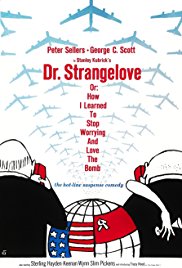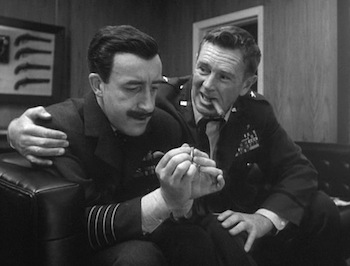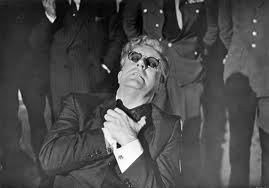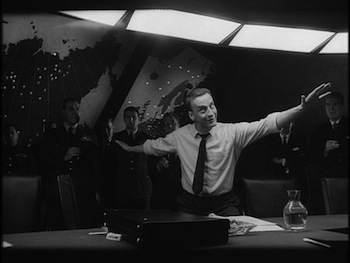DR. STRANGELOVE
Or: How I Learned to Stop Worrying and Love the Bomb
SUBJECTS — U.S./1945 – 1991;
SOCIAL-EMOTIONAL LEARNING — Leadership;
MORAL-ETHICAL EMPHASIS — Trustworthiness.
AGE; 10+; No MPAA Rating;
Satire; 1964, 93 minutes, B&W.
There is NO AI content on this website. All content on TeachWithMovies.org has been written by human beings.

Or: How I Learned to Stop Worrying and Love the Bomb
SUBJECTS — U.S./1945 – 1991;
SOCIAL-EMOTIONAL LEARNING — Leadership;
MORAL-ETHICAL EMPHASIS — Trustworthiness.
AGE; 10+; No MPAA Rating;
Satire; 1964, 93 minutes, B&W.
One of the Best! This movie is on TWM’s short list of the best movies to supplement classes in United States History, High School Level.
TWM offers the following movie worksheets to keep students’ minds on the film and to focus their attention on the lessons to be learned from the movie.
Film Study Worksheet for a Work of Historical Fiction and
Worksheet for Cinematic and Theatrical Elements and Their Effects.
Teachers can modify the movie worksheets to fit the needs of each class. See also TWM’s Historical Fiction in Film Cross-Curricular Homework Project.
It’s the early 1960s. Jack Ripper, an insane U.S. Air Force general obsessed with fears of “the Communist conspiracy,” orders the B-52s under his command to launch a nuclear attack on the Soviet Union. Only General Ripper has the code to recall the bombers. Once the planes are on their way he seals off his base and refuses all communication; telephone calls from the Air Force and from the President go unanswered, while the planes move closer to Russian cities. The President and his advisors gather in the “War Room” and try to figure out how to stop them. The movie is a satiric black comedy about the risks of accidental nuclear war.

Selected Awards:
1964 Academy Award Nominations: Best Picture, Best Director (Kubrick), Best Actor (Sellers), Best Adapted Screenplay; 1964 British Academy Awards: Best Film; 1964 New York Film Critics Awards: Best Director (Kubrick). This film is listed in the National Film Registry of the U.S. Library of Congress as a “culturally, historically or aesthetically significant” film. This film is ranked #26 on the American Film Institute’s List of the 100 Greatest American Movies of All Time (2006). It is ranked #3 on the American Film Institute’s List of the 100 Funniest American Movies of All Time (2006).
Featured Actors:
Peter Sellers, George C. Scott, Sterling Hayden, Keenan Wynn, Slim Pickens, James Earl Jones, Peter Bull and Tracy Reed.
Director:
Stanley Kubrick.
Dr. Strangelove explores the absurdity of the use of nuclear weapons and satirizes the strategy of “Mutual Assured Destruction,” an outrageous and risky policy which, nonetheless, kept the U.S. and the Soviet Union from blowing each other up during the Cold War. The film is thought-provoking and its humor easily leads students to understand the use of absurdity as a tool for the communication of important ideas.
Students will be introduced to nuclear weapons policy (Mutual Assured Destruction) and to the concept of black humor. They will sharpen skills associated with citing sources and supporting ideas as they complete assignments at the end of the film.

Minor. There is only one female character in the movie and she is stereotyped as a secretary/mistress. There is moderate smoking and alcohol use which is the subject of derision.
Assure your child that the film is intended to make them think, not to make them fear the possibility of insane leaders and nuclear warfare.

“Dr. Strangelove” is a classic which contains several of the most memorable sequences and characters ever recorded on film.
The scenes of note in this film include:
The movie has excellent black humor and is brilliantly written, acted, and directed. It should be shown to all children.
The first long-range missiles were the German V-1 and V-2 rockets which terrorized England during WWII. At the end of the war, the United States and the Soviet Union competed to capture and keep the top German engineers. The engineers who had built the V-1s and V-2s became the backbone of the American space program for decades. The most famous of these engineers was Dr. Wernher Von Braun (1912 – 1977). The character of Dr. Strangelove is in part a take off on these engineers. (See The Right Stuff for an exploration of how the seven original U.S. astronauts forced NASA, over the objections of the formerly German engineers, to install manual controls in the space capsules.)
Enrichment Worksheets are a TWM innovation containing text and questions designed to get students thinking. Questions are focused on comprehension, application, analysis, syntheses or evaluation. Questions can be answered in class or as homework, as quick writes, journal entries, formal essays, or research papers. The worksheet for Dr. Strangelove contains an introduction to Mutual Assured Destruction which will help students appreciate the film. For a version of the Worksheet in word processing format, click here.
The United States was engaged in a “Cold War” and a nuclear arms race with the Soviet Union from 1946 until shortly before the collapse of the Soviet Union in 1991. By the mid-1960s, each country could destroy the other with nuclear weapons several times over. In both countries, the policy justifying the maintenance of such overwhelming force was that even in the event of a surprise attack, the country attacked would have enough nuclear capacity left to destroy the attacker. The policy was called “deterrence” or “Mutual Assured Destruction” (MAD).
One of the risks that have haunted people since the advent of the nuclear age is the possibility of nuclear war caused by mistake or by a madman. This movie explores the latter possibility.
Question #1: At last report, Russia has 1800 operational nuclear weapons. The U.S. has more than 2000. These numbers are much reduced from what they were at the height of the Cold War. In addition, China has several hundred that could easily be deployed, France has 290 and the United Kingdom has 160. India and Pakistan claim to have nuclear weapons as well. Isreal denies that it has any, but most people believe that it has more than 100 nuclear bombs. Should we be worried about nuclear war, accidental or intentional? What can be done about it?
Dr. Strangelove was made shortly after the October 1962 Cuban Missile Crisis in which the U.S. and the Soviet Union came very close to nuclear war. In the early 1960s, the U.S. began a program to acquire enough long-range nuclear delivery devices to give it an overwhelming advantage over the Soviet Union. By 1962, the U.S. had a four-to-one advantage over the Russians in nuclear missiles. (At the end of the buildup the U.S. had 1000 Minuteman Missiles, 32 Polaris submarines that could deliver 656 warheads, and 600 B-52 bombers which could carry nuclear bombs.)
The Soviet Union had been humiliated in Berlin where it was forced to build a wall to keep East Germans from fleeing to the West. Nikita Khrushchev, the Soviet dictator, thought that President John F. Kennedy was a weak leader who would not respond to the secret placement of intermediate-range missiles in Cuba that could reach most of the U.S. He sought to humiliate the West and redress some of the imbalance in nuclear forces without the necessity of building a large number of long-range delivery devices. The U.S. discovered the scheme and, after a tense thirteen days in which the entire country seemed to hold its breath, forced the Soviets to agree to dismantle the missiles and take them back to Russia. In return, the U.S. guaranteed that it would not invade Cuba in an effort to overthrow Fidel Castro’s communist government. The U.S. also made a secret promise to the Soviets to remove outdated medium-range nuclear missiles from Turkey within six months. The Cuban Missile Crisis was seen as a tremendous victory for the United States and a defeat for Russia.
Question #2: In the 1960s some people built bomb shelters under their houses. Some were equipped with guns and the doors had very strong locks. In case of a nuclear war, would you shoot your neighbors to keep them out of your bomb shelter? Describe the pros and cons.
After the Cuban Missile Crisis, the Soviets were determined never to be caught short again. They embarked on a massive nuclear arms buildup to ensure that they had more than enough ballistic missiles to destroy the U.S.
To further the policy of Mutual Assured Destruction it was important that neither side be able to adequately defend against a nuclear attack. This led to some very strange results. Defensive weapons were seen as destabilizing. Thus, the U.S. and the Soviet Union entered into an anti-ballistic missile treaty in which they agreed to limit the deployment of weapons to defend against a missile attack. Another absurd result was that, in order to prevent either side from developing the capability of destroying the other side’s nuclear deterrent in a first strike, silos for nuclear missiles were hardened so that they could withstand anything except a direct hit, while cities containing millions of people were left totally undefended. While millions were spent on civil defense, everyone knew that the programs would do little to help people in case there was a full-scale nuclear exchange.
During the late 1950s and early 1960s, a number of theoreticians and the media explored the possible effects of nuclear war and the use of nuclear weapons. Edward Teller, a prominent nuclear physicist, was an advocate for developing the hydrogen bomb. Henry Kissinger (later a distinguished U.S. Secretary of State from 1973 – 1977 who won the 1993 Nobel Peace Prize for negotiating an end to the war in Vietnam) suggested that the use of tactical nuclear weapons was an option that decision-makers must consider. Herman Kahn, an author, and Rand Corporation expert, indulged in speculation about the estimated worldwide genetic consequences of fallout from a nuclear war, potential casualties, and even the likelihood of vomiting in fallout shelters after a nuclear blast. Kahn defined the desirable characteristics of a deterrent: frightening, inexorable, persuasive, cheap, non-accident prone, and controllable. (The Dr. Strangelove character is an amalgam of individuals such as the men described above, as well as the prototypical German engineer who worked for the Nazis but after WWII was employed by the U.S. government for his technical expertise.)
The concept of the survivable nuclear war was also discussed in the mass media. A U.S. News and World Report cover article entitled “If Bombs Do Fall” discussed plans to allow people to write checks on their bank even if it had been obliterated in a nuclear attack. Another article in the magazine claimed that the survivors of the U.S. atomic bombing of Japan were doing quite well. Life Magazine also had a cover story with the headline “How You Can Survive Fallout, 97 out of 100 Can Be Saved” advising that the best cure for radiation sickness was hot tea or a solution of baking soda. [The last two paragraphs are adapted from Bibliography Entry #4 in the Supplemental Materials.]
Question #3: Give your opinion on the following statement and explain your reasons: Every dollar that the U.S. spends on its nuclear arsenal is wasted and we have better uses for our money to reduce the deficit or provide education or to give healthcare.
The director, Stanley Kubrick, who also wrote the screenplay, to Dr. Strangelove, Or: How I Learned to Stop Worrying and Love the Bomb had read widely about nuclear arms strategy. He originally intended to make a film that was a serious examination of the risks of nuclear war. However, as he tried to imagine the way things would really happen, ideas came to him which he discarded because they were so ludicrous that people would laugh. After a month or so he realized that the ideas he was throwing out were the best and the most truthful. He then switched the tenor of the film from drama to satire and black humor. It says something about the seriousness of the topic of nuclear war that it is so terrifying that it can only be dealt with by laughing at it and at ourselves.
Black humor expresses the “absurdity, insensitivity, paradox, and cruelty of the modern world.” The novels of such writers as Kurt Vonnegut, Thomas Pynchon, John Barth, Joseph Heller, and Philip Roth also contain elements of black humor. (The Columbia Encyclopedia, Sixth Edition. 2001) Black humor has been described as being “pitched at the breaking point where moral anguish explodes into a mixture of comedy and terror, where things are so bad you might as well laugh.” [Morris Dickstein, Gates of Eden: American Culture in the Sixties (New York, Basic Books, 1977) 92 – 127] Dr. Strangelove is probably the prime example of black humor in the film. Remember, “A nuclear war can ruin your whole day.”
After the film has been watched, engage the class in a discussion about the movie.
1. During the Cold War, some people accepted the inevitability of a nuclear war and tried to plan for it. Many people objected that this type of thinking desensitized leaders, making them more likely to start a nuclear war with casualties of 20 – 50 million Americans and as many Russians. Which position makes sense to you?
Suggested Response:
All answers, well argued, are acceptable.
2. During the Cold War, the United States and the Soviet Union were pursuing a policy of mutual assured destruction (MAD), a policy which, in hindsight, effectively prevented a nuclear war. What is the logic behind MAD? Could you personally pull the nuclear trigger and kill a hundred million Russians, even if hundreds of Russian nuclear bombs were on their way to the U.S.?
Suggested Response:
Answers will vary and all well-reasoned opinions are acceptable.
3. The humor in the film is intended to make viewers think of the absurdity of such concepts as MAD and even the possibility of deciding to use nuclear bombs. Do you think the humor is effective in getting you to see the point of the film and to turn against the idea of using nuclear weapons? Refer to a specific incident of humor in the film and to clarify the point being made.
Suggested Response:
Answers will vary.
4. What was the policy of Mutually Assured Destruction? Did it work?
Suggested Response:
Each superpower, the U.S. and the U.S.S.R. could destroy the other with nuclear weapons, no sneak attack or defensive measures would work. Thus, it was insane for either to use nuclear weapons. As to whether it worked, we’re still here, aren’t we?
5. During the Cold War, when the United States and the Soviet Union were pursuing a policy of mutual assured destruction (MAD), why were missiles that could permit a defense against nuclear attack seen as dangerous and destabilizing?
Suggested Response:
The idea behind MAD was that neither party could survive a nuclear strike by the other. Defensive weapons upset that equation.
6. Why did Dr. Strangelove call the President “mein Führer”? Who was the Führer?
Suggested Response:
He was German and had worked for the Nazis in WWII.
7. Did you agree with Dr. Strangelove’s suggestion that the Americans should try to defeat the doomsday machine by living in tunnels for a hundred years at a ratio of 1 man to 10 women?
8. What did you think of King Kong (the pilot)?
Suggested Response:
He was blind to what he was doing. He was an anachronism, with his frame of reference relating to an earlier type of war.
9. During the Cold War, there were some people who accepted the inevitability of a nuclear war and tried to plan for it. Many people objected that this type of thinking desensitized leaders, making them more likely to start a nuclear war with casualties of 20 – 50 million Americans and as many Russians. Which position makes sense to you? Explain your reasoning.
Suggested Response:
There is no one right answer to this question. We should never lose our sensitivity where death and injury are concerned. Whether planning for nuclear war decreases one’s sensitivity depends upon the person. However, it should be pointed out that this was a real dilemma during the Cold War. General Curtis LeMay, Chief of Staff of the U.S. Air Force during the 1962 Cuban Missile Crisis thought that nuclear war with the Russians was inevitable and that the Cuban Missile Crisis provided a good occasion to start one. Statement by McNamara interviewed in “The Fog of War” See also Thirteen Days by Robert F. Kennedy, p. 119, statement attributed to “one of the Joint Chiefs of Staff” At that time the U.S. had a large lead over the Russians in nuclear weapons and delivery devices. However, the Russians could still destroy most of the major cities in the U.S. and Western Europe. Had President Kennedy taken LeMay’s advice, nuclear war would have been much more likely. But President Kennedy believed that since nuclear war would cause casualties in the hundreds of millions, it should be avoided if at all possible. He therefore engineered a resolution of the crisis in which the Russian missiles were removed, the honor and prestige of the U.S. was increased, and there was no nuclear war. See Learning Guide to “Thirteen Days“.
1. Describe the leadership style of President Muffley. What did he do with all the bad advice that was given to him?
2. What did you think of General Turgidson (played by George C. Scott)? Was he a leader or a follower? Did he show good judgment in some of the solutions that he proposed?
3. Did you think that President Muffley, as portrayed in the movie, provided good leadership?
Discussion Questions Relating to Ethical Issues will facilitate the use of this film to teach ethical principles and critical viewing. Additional questions are set out below.
(Be honest; Don’t deceive, cheat or steal; Be reliable — do what you say you’ll do; Have the courage to do the right thing; Build a good reputation; Be loyal — stand by your family, friends, and country)
1. Was President Muffley right to try to call back the bombers and to give the Soviets information so that they could shoot down the bombers that could not be called back?
2. Was the Soviet Ambassador doing the right thing when he tried to take pictures of the War Room? If the roles were reversed, would you have expected the U.S. Ambassador to try to take pictures of the Soviet War Room?
Any of the discussion questions can serve as a writing prompt. Additional assignments include:
1. Research and write an informative essay on the perpetration of fear of nuclear warfare that occurred during the Cold War. Look for political speeches, newspaper and magazine articles and the variety of policies that were fear based. For example, during the 1950s, children had to bring a change of clothing to school with them in order to clean off any fall-out; backyard bomb shelters were sold by Sears.
2. The United States is the only country in the world that has used atomic energy as a weapon. Some analysts say that the use of the atomic bombs on Hiroshima and Nagasaki was unnecessary, that Japan had been defeated and it was only a matter of time before it surrendered. Others say that Japan would never have given up and that an Allied invasion would have cost tens of thousands of Allied casualties and hundreds of thousands of Japanese would have died from hunger and disease if there had been an invasion. Still others say that President Truman ordered the use of atomic bombs to impress Josef Stalin that if he tried to use the massive Red Army to overrun Western Europe, the U.S. would use atomic bombs to stop them. Write a formal paper evaluating these theories.
3. Research and cite support for an analysis of the actual danger of nuclear warfare in modern times. Address the efforts of the Nuclear Disarmament groups that have work tirelessly over decades to minimize such threats. Be sure to include estimates of the capabilities of “rogue” nations to wage nuclear war.
See also Additional Assignments for Use With any Film that is a Work of Fiction.
This film was originally intended to be based upon the novel Red Alert by Peter George, III. We have not read it.
In addition to websites which may be linked in the Guide and selected film reviews listed on the Movie Review Query Engine, the following resources were consulted in the preparation of this Learning Guide:
This Learning Guide was last updated on September 29, 2012.